Influence of Fault Dip Angle and Strength on Fault Slip Characteristics of Gas Storage
Abstract
:1. Introduction
2. Materials and Methods
2.1. Preparation of Test Samples
2.2. Test Methods
3. Results
3.1. Failure Characteristic Analysis
3.2. Analysis of Strength-Deformation Characteristics
3.3. Fault Damage Analysis
3.4. Analysis of Critical Slip Points of Gas Storage Faults under the Alternating Stress
4. Conclusions and Discussion
- (1)
- During fault failure, the strength of fault clay and fault inclination significantly affect the mode and intensity of failure. A higher fault clay strength correlates with increased failure intensity, leading to a more extensive crack propagation upon fault failure, a gradual convergence of the failure location towards the fault core from the periphery, and the development of shear cracks oblique to the fault plane. As fault inclination increases, the failure intensity tends to decrease, resulting in reduced sample damage.
- (2)
- With increasing fault clay strength, the overall compression, fault slip, and fault compression of fault samples exhibit a trend of an initial decrease followed by an increase. The inflection point for 30° faults occurs at a ratio of around 1.7/1 between rock strength and fault clay strength, while for 45° faults, the inflection point is near 1.2/1.
- (3)
- Fault clay strength plays a decisive role in the damage to faults under cyclic loading conditions. A higher fault strength leads to lower dissipated energy and higher elastic energy proportions at the same number of loading cycles. Furthermore, for the same number of loading cycles and fault clay, a greater fault inclination results in more severe fault damage.
- (4)
- The maximum static friction coefficient represents the fault’s resistance to slip. Overall, the static friction coefficient of 30° faults is higher than that of 45° faults. The static friction coefficient of 30° faults demonstrates nonlinear growth with increasing fault clay strength, while that of 45° faults shows nearly linear growth.
Author Contributions
Funding
Data Availability Statement
Acknowledgments
Conflicts of Interest
References
- Ding, G.; Wang, Y.; Wanyan, Q.; Wang, J.; Xu, H.; Li, K.; Xia, Y.; Li, L.; Zeng, D.; Liu, Z. Construction difficulties and research directions of various complex UGSs. Nat. Gas Ind. 2023, 43, 14–23. [Google Scholar]
- Ma, X.; Zheng, D.; Ding, G.; Wang, J. “Extreme utilization” theory and practice in gas storageswith complex geological conditions. Pet. Explor. Dev. 2023, 50, 373–383. [Google Scholar] [CrossRef]
- Guo, S.; Li, Y.; Zhang, Y.; Xu, S.; Zheng, D.; Ren, J.; Bu, Y.; Pang, X. The excellent adaptability to large temperature differences of alkali-activated slag using Na2SO4+ Ca(OH)2 as the activator. Constr. Build. Mater. 2024, 431, 136514. [Google Scholar] [CrossRef]
- Wang, C.; Gao, G.; Jia, J.; Chang, C.; Wu, Z. Variation of stress field and fault slip tendency induced byinjection and production in the H underground gas storage. Nat. Gas Ind. 2020, 40, 76–85. [Google Scholar]
- Ke, W.; Zeng, H.; Wang, Z.; Yu, H.; Liu, Y.; Zheng, D.; Zhu, J.; Zhu, H. A Numerical Study on Labyrinth Screw Pump (LSP) Performance under Viscous Fluid Flow. Energies 2023, 16, 5997. [Google Scholar] [CrossRef]
- Caine, J.S.; Evans, J.P.; Forster, C.B. Fault zone architecture and permeability structure. Geology 1996, 24, 1025–1028. [Google Scholar] [CrossRef]
- Cello, G.; Tondi, E.; Micarelli, L.; Invernizzi, C. Fault zone fabrics and geofluid properties as indicators of rock deformation modes. J. Geodyn. 2001, 32, 543–565. [Google Scholar] [CrossRef]
- Brogi, A. Fault zone architecture and permeability features in siliceous sedimentary rocks: Insights from the Rapolano geothermal area (Northern Apennines, Italy). J. Struct. Geol. 2008, 30, 237–256. [Google Scholar] [CrossRef]
- Zhang, X.; Sun, Z.; Zhao, J.; Pan, Y.; Wu, M. Study on the Influence of Strike-slip Fault Displacement on Reservoir in Northern Slope, Tazhong Area. Geoscience 2014, 28, 1017–1022. [Google Scholar]
- Zheng, H.; Hu, Z.; Yun, L.; Lin, H.; Deng, S.; Jia, H.; Pu, Y. Strike-slip faults in marine cratonic basins in China:Development characteristics and controls on hydrocarbon accumulation. Earth Sci. Front. 2022, 29, 224–238. [Google Scholar]
- Wu, M.; Liu, Y.; Peng, P.; Chai, X.; Yan, N. Characteristics of strike-slip faults in Lunnan buried hill and its influence on hydrocarbon accumulation. Fault Block Oil Gas Field 2021, 28, 456–462. [Google Scholar]
- Peng, C.; Xiao, Y.; Fu, J.; Cao, Q.; Zhang, J.; Su, Y.; Zhang, H.; Wan, X.; Zheng, D. Numerical validation of a novel cuttings bed impeller for extended reach horizontal wells. Pet. Res. 2024; in press. [Google Scholar] [CrossRef]
- Wu, Y.; Sun, C.; Wang, D.; Jiang, T.; Huang, Y.; Gong, J. Hydrocarbon distribution characteristics and main controlling factors of accumulation in South Konys Oilfield in South Turgay Basin, Kazakhstan. Nat. Gas Geosci. 2016, 27, 2013–2022. [Google Scholar]
- Lan, X.; Lv, X.; Zhu, Y.; Li, S.; Xie, E. Hydrocarbon accumulation pattern jointly controlled by strike-slip faults and cap rocks:a case from Yingshan Formation in ZG-51 wellblock of eastern Tazhong area, Tarim Basin. Oil Gas Geol. 2014, 35, 107–115. [Google Scholar]
- Jia, X. Numerical simulation of the effect of fault inclination on faultactivation and water inrush from floor. Coal Eng. 2017, 49, 90–93. [Google Scholar]
- Piao, W.; Mao, X. Research on effect of fault dip on fault activation andwater inrush of coal floor. Chin. J. Rock Mech. Eng. 2009, 28, 386–394. [Google Scholar]
- Li, Z.; Zhou, M.; Huang, H.; Tong, Y.; Zhang, W. Mechanical and constitutive characterization of gouge considering cementation. J. Basic Sci. Eng. 2024; in press. [Google Scholar]
- Ma, Z.; Zeng, J.; Zhao, L.; Wu, Y.; Xu, X.; Li, D. Experimental simulation for the influence of fault property and dip angle on petroleum migration and accumulation in Jiyang Depression. Lithol. Reserv. 2008, 20, 109–113. [Google Scholar]
- Jia, B.; Li, B.; Zhou, L.; Chen, H. Experimental study on the influence of fault dip angle on acoustic emission sinalpropagation. Coal Sci. Technol. 2024; in press. [Google Scholar]
- Li, C.; Yu, W.; Ding, J. Quantitative evaluation of fault sealing by Weighted Shale Gouge Ratio(WSGR): A case study of Yongan area in Gaoyou Sag, Subei Basin. Pet. Geol. Expr. 2024, 46, 158–165. [Google Scholar]
- Xie, L.; Liu, H.; Ban, S.; Mao, H.; Xia, D.; Song, Y.; Tong, R.; Ying, Q. Experimental study on shear properties of fault gouge withdifferent mineral compositions. Rock Soil Mech. 2023, 44, 2545–2554. [Google Scholar] [CrossRef]
- Zhang, J. Study on causes and preventive measures of coring and plugging in complex formation. China Mine Eng. 2021, 50, 52–55. [Google Scholar] [CrossRef]
- Li, X.; Li, K.; Liang, J.; Yin, H.; Wang, Z.; Sun, J.; Zhang, Y. Analysis of core-blocking causes in complex formation core drilling and its preventive measures. Explor. Eng. (Rock Soil Drill. Tunn.) 2018, 45, 12–15. [Google Scholar]
- He, X.P.; Sinan, M.; Kwak, H.; Hoteit, H. A corrected cubic law for single-phase laminar flow through rough-walled fractures. Adv. Water Resour. 2021, 154, 103–984. [Google Scholar] [CrossRef]
- Chen, X.; Xiao, Y.; Tang, M.; Jiao, T.; Zhang, F. Experimental study on deformation, permeability and AE characteristics ofsandstone under multi-stage cyclic loading with a constant amplitude. Chin. J. Rock Mech. Eng. 2024, in press. [CrossRef]
- Duyi, Y.; Zhenlin, W. A new approach to low-cycle fatigue damage based on exhaustion of static toughness and dissipation of cyclic plastic strain energy during fatigue. Int. J. Fatigue 2001, 23, 679–687. [Google Scholar] [CrossRef]
- Xiao, J.-Q.; Ding, D.-X.; Jiang, F.-L.; Xu, G. Fatigue damage variable and evolution of rock subjected to cyclic loading. Int. J. Rock Mech. Min. Sci. 2009, 47, 461–468. [Google Scholar] [CrossRef]
- Zhou, H.; Hou, W.; Zhang, L.; Xie, S.; Jia, W.; Shi, B. Constitutive model of coal considering temperature under cyclic loading andunloading conditions. J. China Coal Soc. 2024, 49, 442–453. [Google Scholar] [CrossRef]
- Li, X.; Yao, Z.; Huang, X.; Liu, Z.; Zhao, X.; Mu, K. Investigation of deformation and failure characteristics and energy evolution ofsandstone under cyclic loading and unloading. Rock Soil Mech. 2021, 42, 1693–1704. [Google Scholar] [CrossRef]
- Yang, L.; Gao, F.; Wang, X.; Li, J. Energy evolution law and failure mechanism of coal-rockcombined specimen. J. China Coal Soc. 2019, 44, 3894–3902. [Google Scholar] [CrossRef]
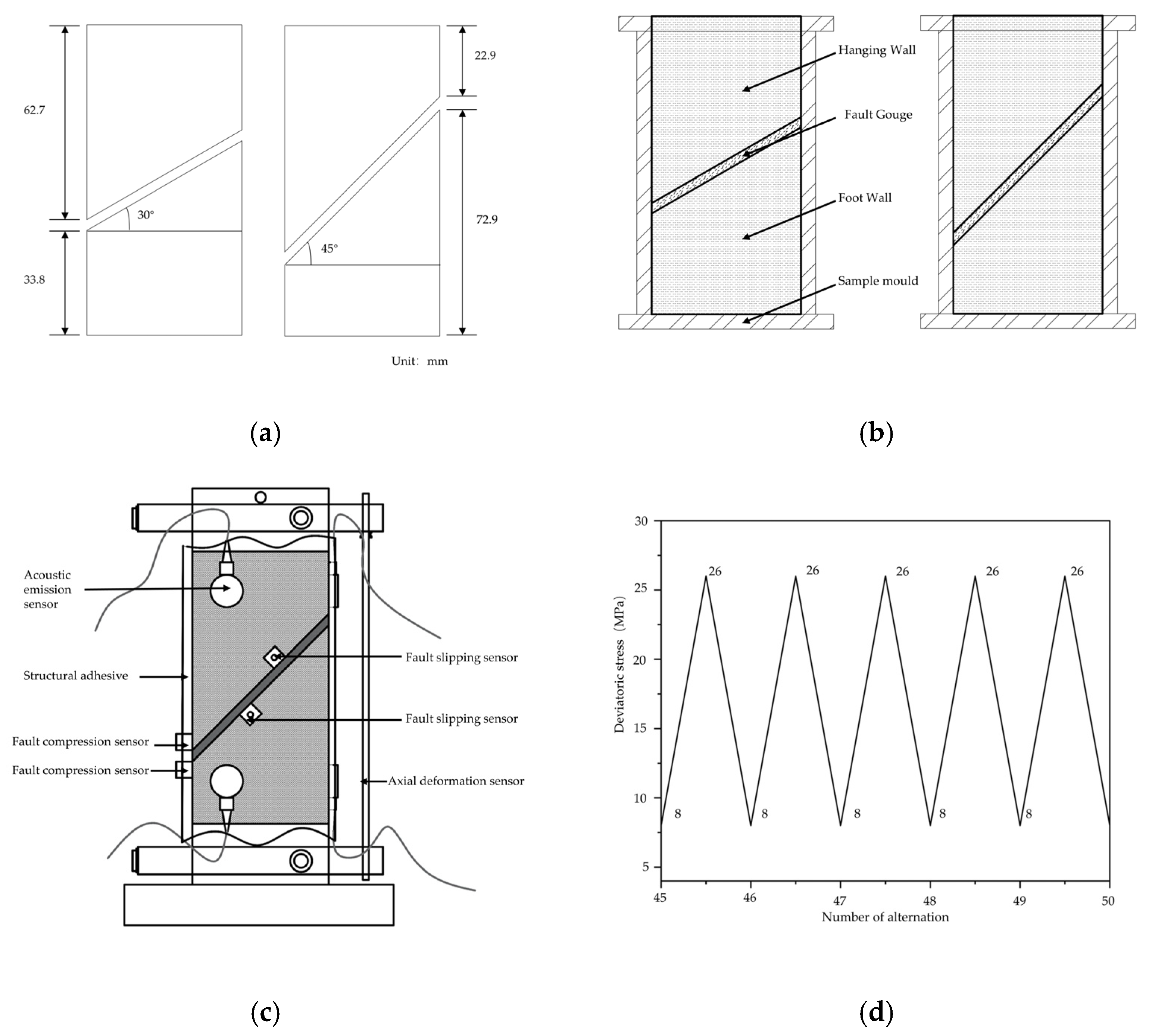
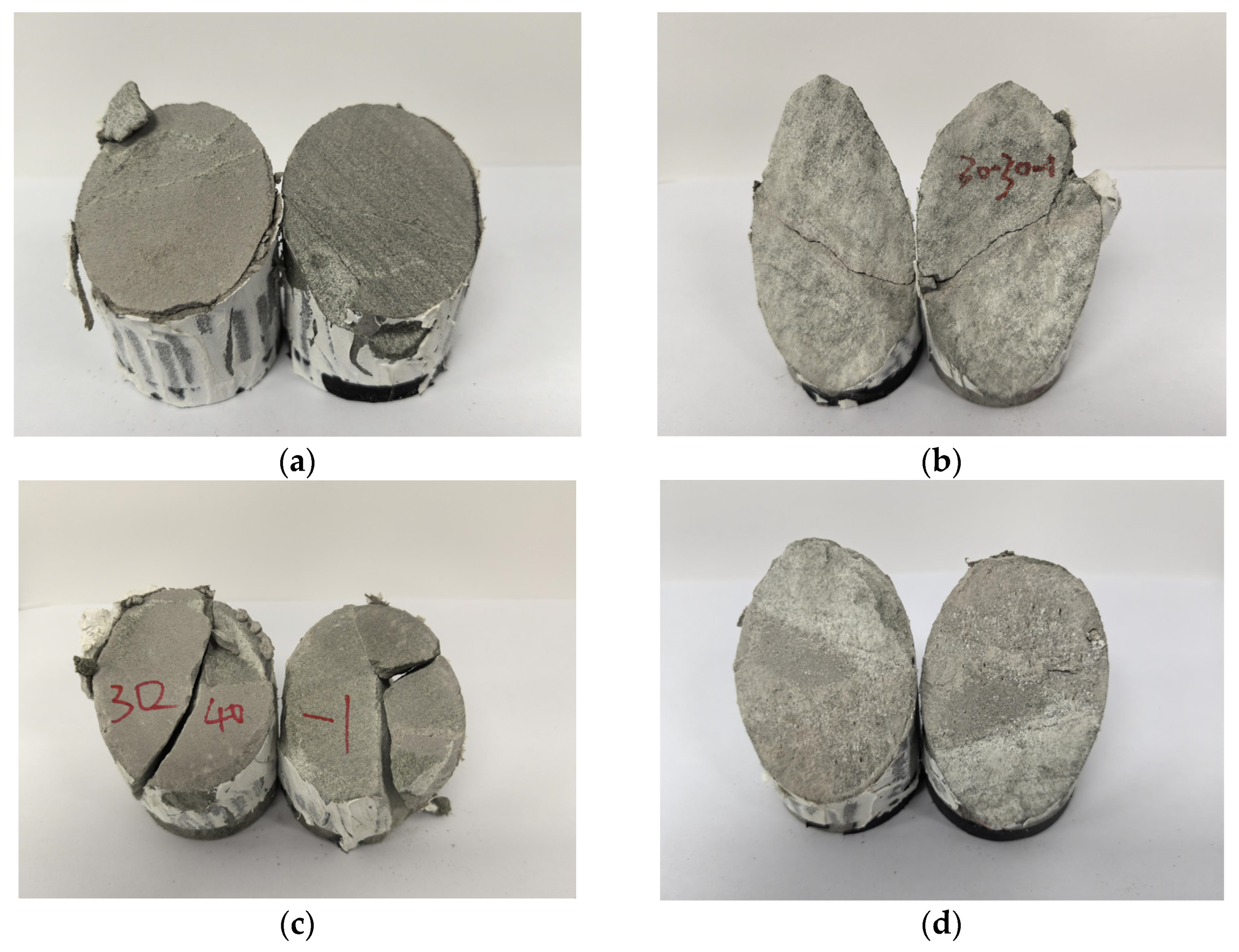
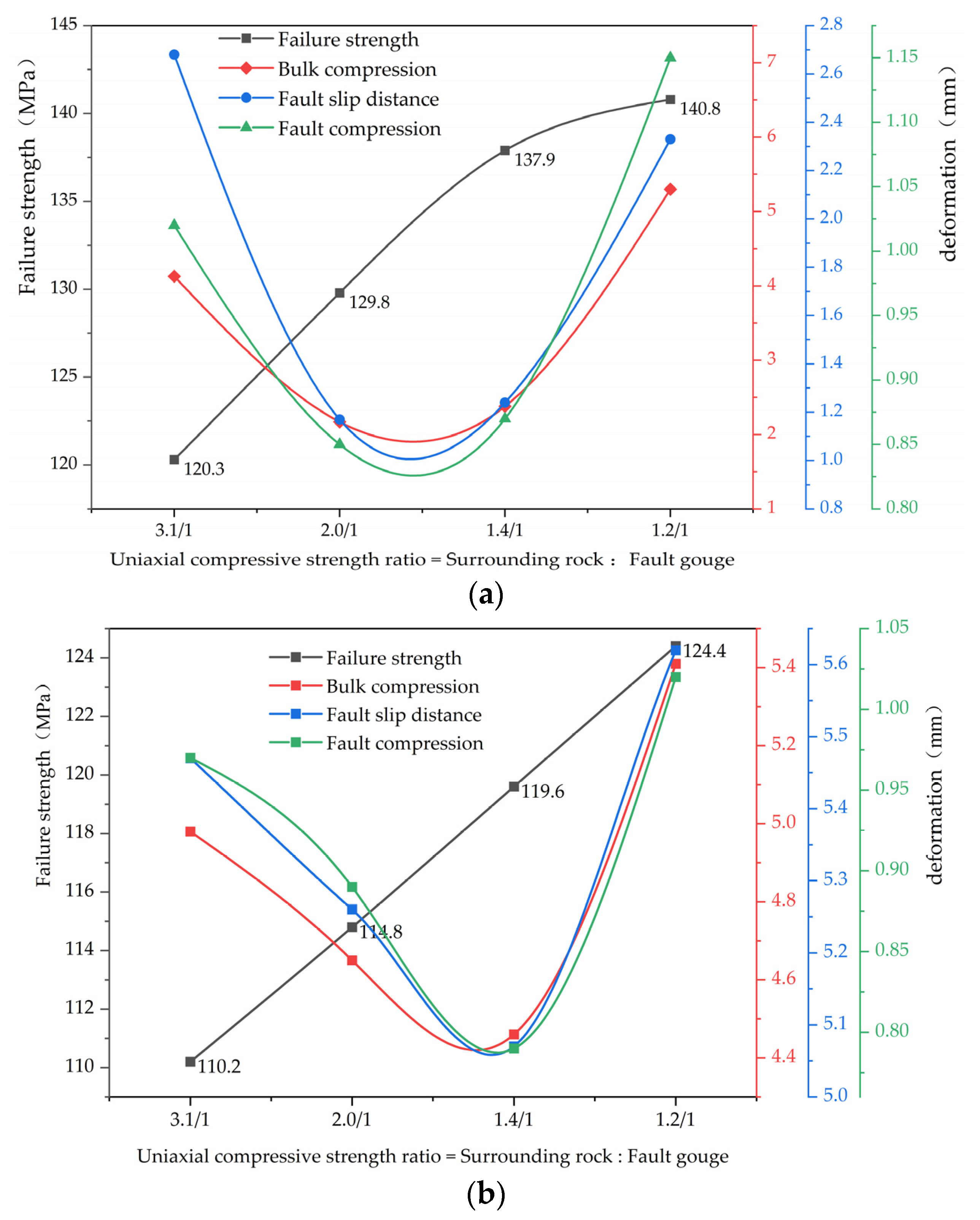
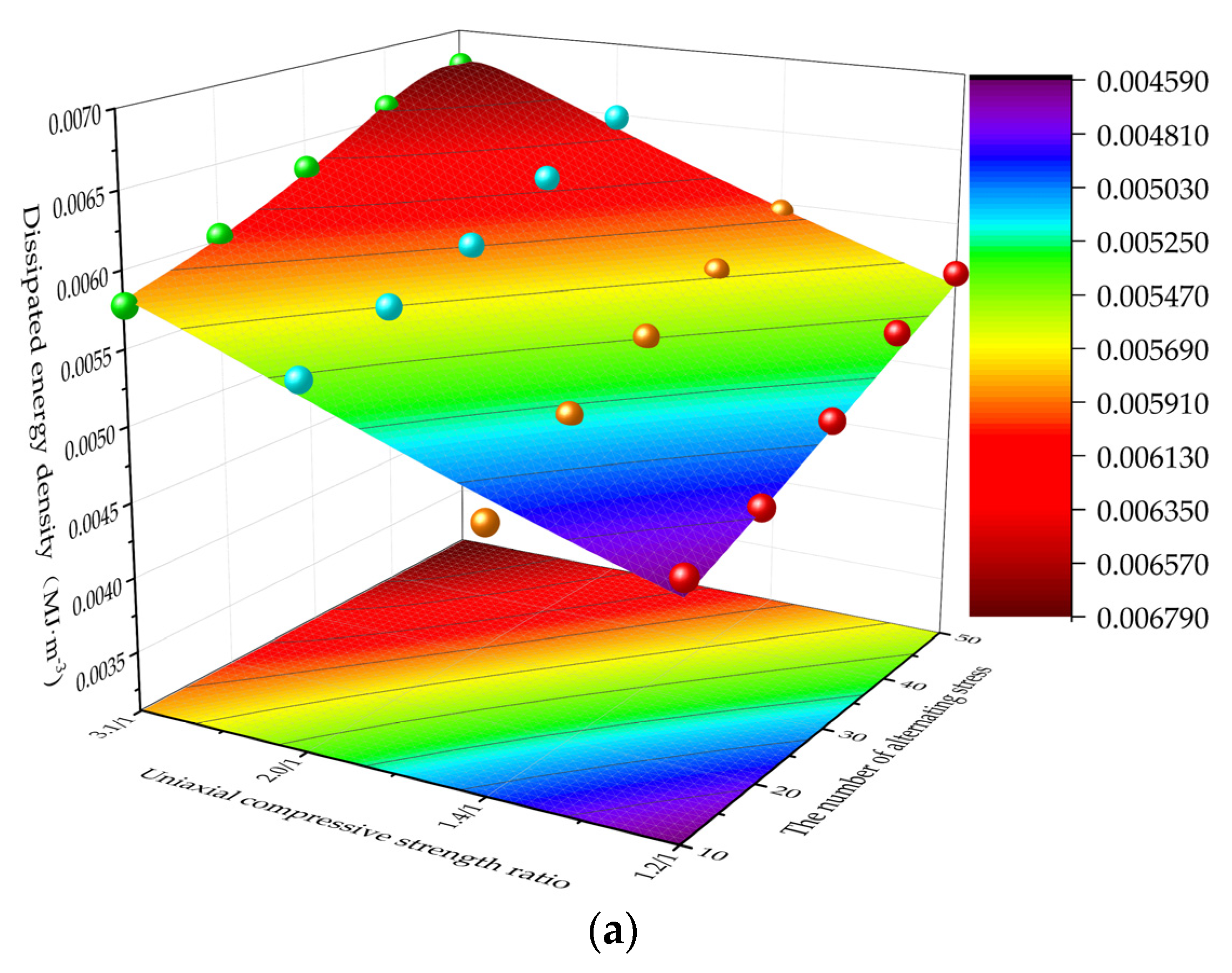
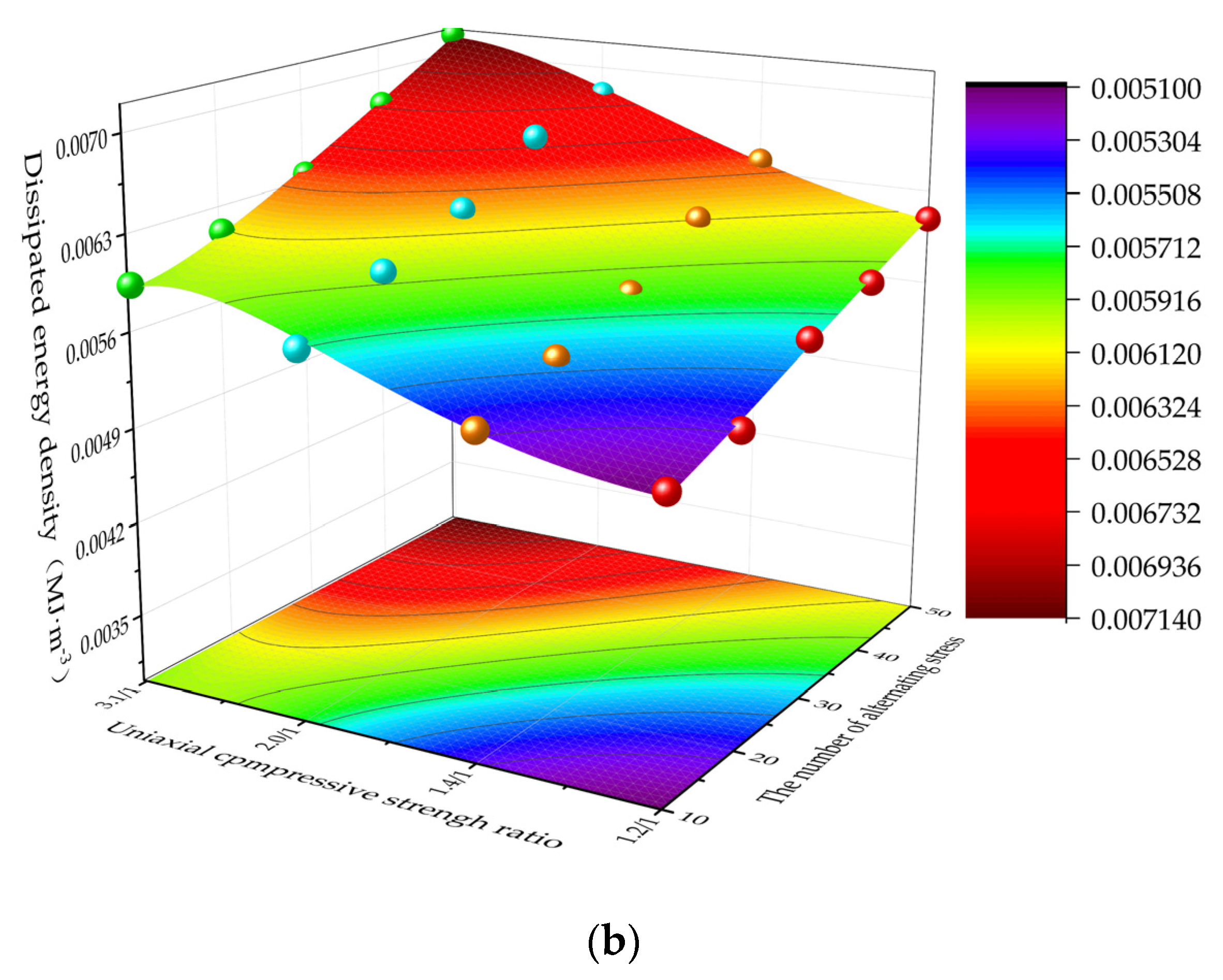
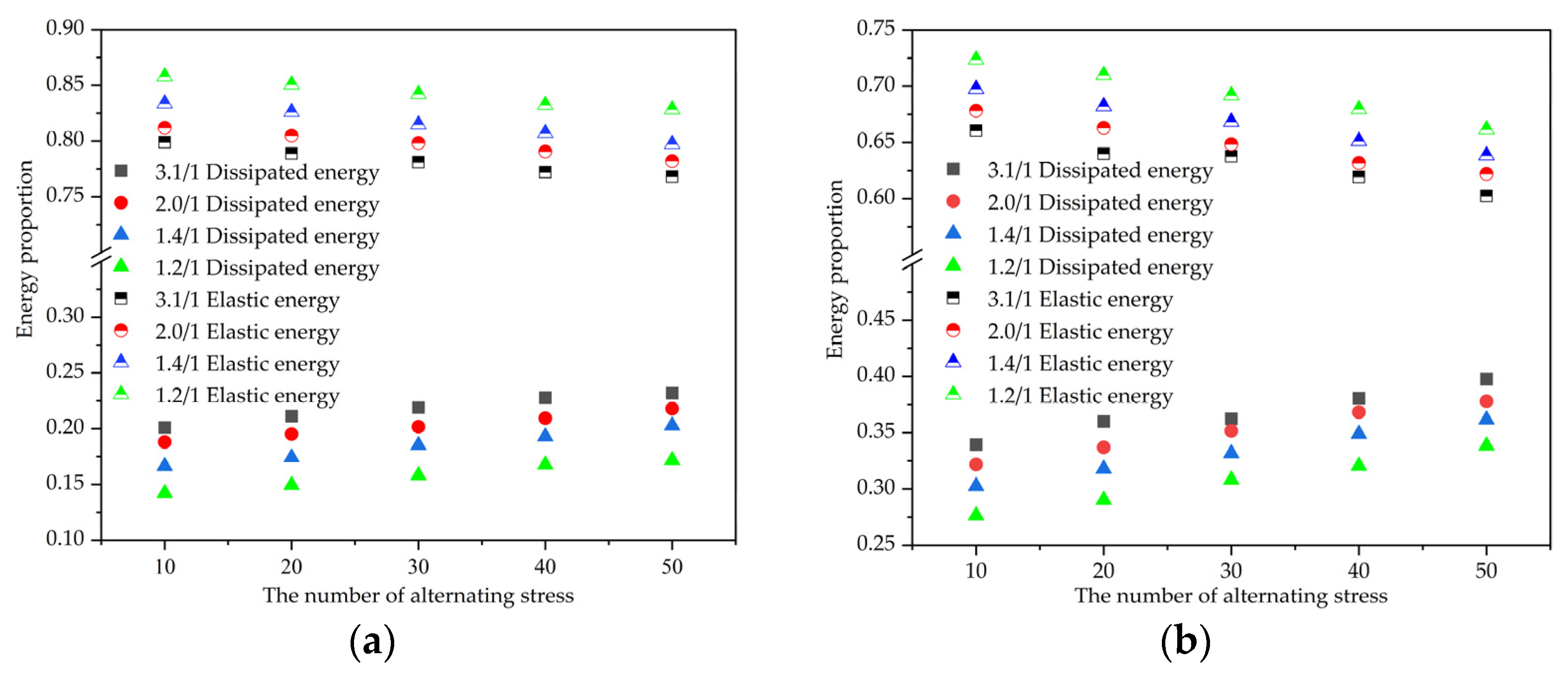

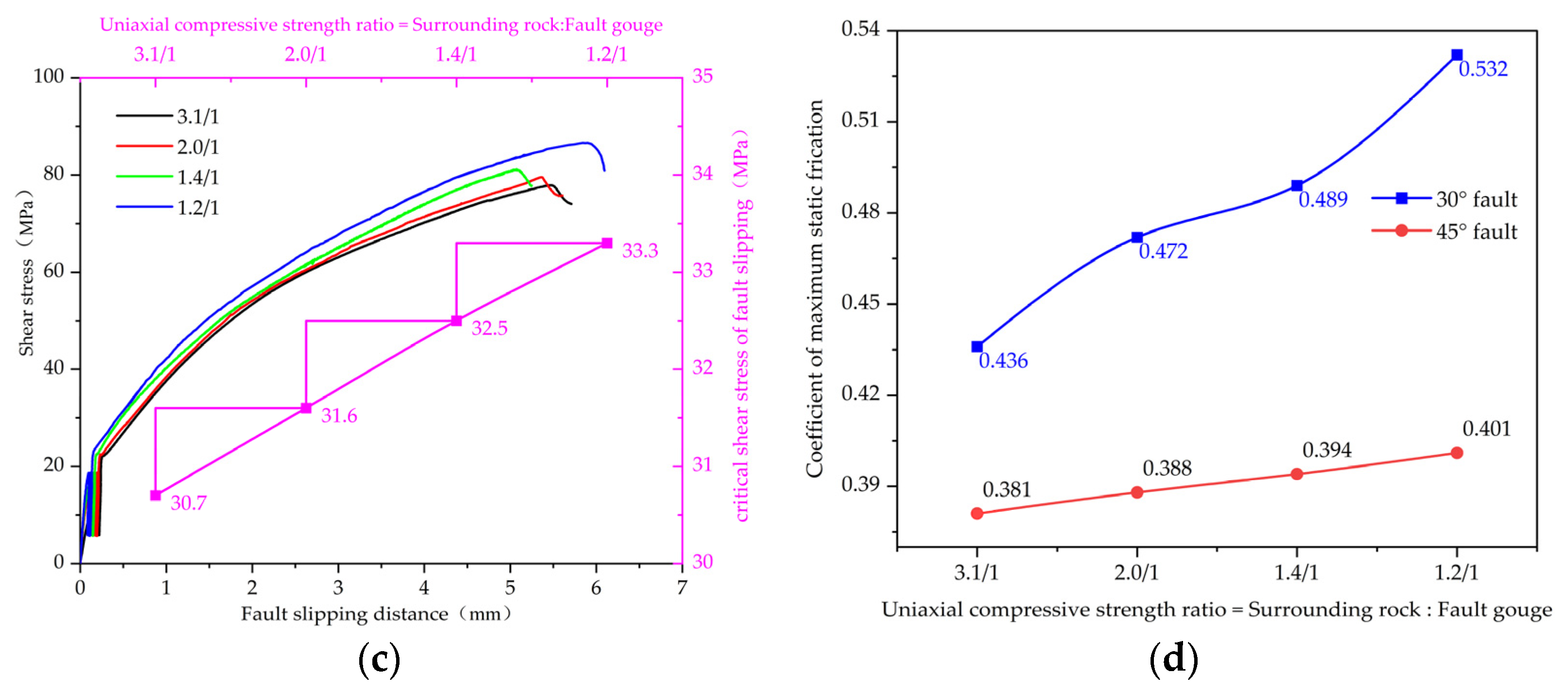
| Lithologic Category | Modulus of Elasticity (GPa) | Poisson’s Ratio | Uniaxial Compressive Strength (MPa) | Cohesive Force (MPa) | Angle of Internal Friction (°) | Density (kg · m−3) |
|---|---|---|---|---|---|---|
| Fault gouge | 3.69 | 0.12 | 20.1 | 3.02 | 30 | 1959.31 |
| 4.87 | 0.12 | 30.2 | 8.14 | 31 | 1962.68 | |
| 5.50 | 0.11 | 42.4 | 8.56 | 36 | 1969.72 | |
| 5.73 | 0.10 | 51.4 | 8.99 | 41 | 1956.73 | |
| Surrounding rock | 6.85 | 0.31 | 62.5 | 10.81 | 45 | 2263.12 |
Disclaimer/Publisher’s Note: The statements, opinions and data contained in all publications are solely those of the individual author(s) and contributor(s) and not of MDPI and/or the editor(s). MDPI and/or the editor(s) disclaim responsibility for any injury to people or property resulting from any ideas, methods, instructions or products referred to in the content. |
© 2024 by the authors. Licensee MDPI, Basel, Switzerland. This article is an open access article distributed under the terms and conditions of the Creative Commons Attribution (CC BY) license (https://creativecommons.org/licenses/by/4.0/).
Share and Cite
Cheng, S.; Ding, G.; Wu, Z.; Qiu, X.; Xu, H.; Liu, B. Influence of Fault Dip Angle and Strength on Fault Slip Characteristics of Gas Storage. Processes 2024, 12, 1869. https://doi.org/10.3390/pr12091869
Cheng S, Ding G, Wu Z, Qiu X, Xu H, Liu B. Influence of Fault Dip Angle and Strength on Fault Slip Characteristics of Gas Storage. Processes. 2024; 12(9):1869. https://doi.org/10.3390/pr12091869
Chicago/Turabian StyleCheng, Songlin, Guosheng Ding, Zhide Wu, Xiaosong Qiu, Haitao Xu, and Bingbing Liu. 2024. "Influence of Fault Dip Angle and Strength on Fault Slip Characteristics of Gas Storage" Processes 12, no. 9: 1869. https://doi.org/10.3390/pr12091869




